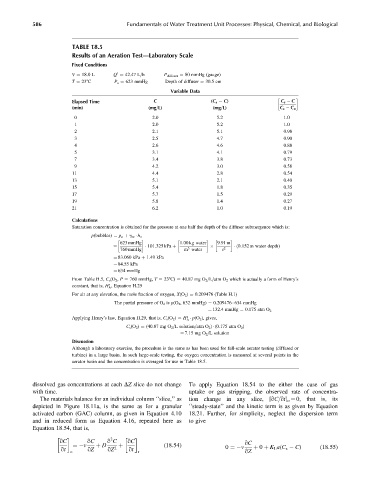Page 631 - Fundamentals of Water Treatment Unit Processes : Physical, Chemical, and Biological
P. 631
586 Fundamentals of Water Treatment Unit Processes: Physical, Chemical, and Biological
TABLE 18.5
Results of an Aeration Test—Laboratory Scale
Fixed Conditions
V ¼ 18.0 L Q ¼ 42.47 L=h P diffuser ¼ 80 mmHg (gauge)
0
T ¼ 238C P a ¼ 623 mmHg Depth of diffuser ¼ 30.5 cm
Variable Data
Elapsed Time C (C s C) C s C
(min) (mg=L) (mg=L) C s C o
0 2.0 5.2 1.0
1 2.0 5.2 1.0
2 2.1 5.1 0.98
3 2.5 4.7 0.90
4 2.6 4.6 0.88
5 3.1 4.1 0.79
7 3.4 3.8 0.73
9 4.2 3.0 0.58
11 4.4 2.8 0.54
13 5.1 2.1 0.40
15 5.4 1.8 0.35
17 5.7 1.5 0.29
19 5.8 1.4 0.27
21 6.2 1.0 0.19
Calculations
Saturation concentration is obtained for the pressure at one half the depth of the diffuser submergence which is:
p(bubbles) ¼ p a þ g w h o
623 mmHg 1:00 kg water 9:91 m
(0:152 m water depth)
¼ 101:325 kPa þ 3 2
760 mmHg m water s
¼ 83.060 kPa þ 1.49 kPa
¼ 84.55 kPa
¼ 634 mmHg
From Table H.5, C s (O 2 , P ¼ 760 mmHg, T ¼ 238C) ¼ 40.87 mg O 2 =L=atm O 2 which is actually a form of Henry’s
s
constant, that is, H , Equation H.29
A
For air at any elevation, the mole fraction of oxygen, X(O 2 ) ¼ 0.209476 (Table H.1)
The partial pressure of O 2 is p(O 2 , 632 mmHg) ¼ 0.209476 634 mmHg
¼ 132.4 mmHg ¼ 0.175 atm O 2
s
Applying Henry’s law, Equation H.29, that is, C s (O 2 ) ¼ H p(O 2 ), gives,
A
C s (O 2 ) ¼ (40.87 mg O 2 =L solution=atm O 2 ) (0.175 atm O 2 )
¼ 7.15 mg O 2 =L solution
Discussion
Although a laboratory exercise, the procedure is the same as has been used for full-scale aerator testing (diffused or
turbine) in a large basin. In such large-scale testing, the oxygen concentration is measured at several points in the
aerator basin and the concentration is averaged for use in Table 18.5.
dissolved gas concentrations at each DZ slice do not change To apply Equation 18.54 to the either the case of gas
with time. uptake or gas stripping, the observed rate of concentra-
The materials balance for an individual column ‘‘slice,’’ as tion change in any slice, [qC=qt] o ¼ 0, that is, its
depicted in Figure 18.11a, is the same as for a granular ‘‘steady-state’’ and the kinetic term is as given by Equation
activated carbon (GAC) column, as given in Equation 4.10 18.21. Further, for simplicity, neglect the dispersion term
and in reduced form as Equation 4.16, repeated here as to give
Equation 18.54, that is,
2
qC qC q C qC qC
¼ v þ D (18:54)
qt qZ qZ 2 þ qt 0 ¼ v þ 0 þ K L a(C s C) (18:55)
o r qZ

